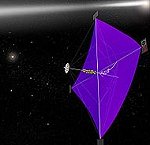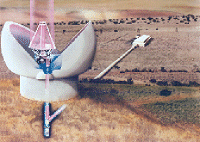|
Solar energy is an abundant source of power
for spacecraft navigating the inner solar system. But how far away
from our star can photovoltaics work?
by Gil Knier and Dr Tony Phillips
Try this: Close your eyes for a moment
and imagine the International Space Station (ISS), sunlit and gleaming
as it circles our planet.
What did it look like? The lingering
image in your mind is probably dominated by broad, beautiful wings
- the station's awesome solar arrays.
It's
no accident that solar panels dominate the station's profile. On
the ISS (as on the earth below) solar energy ultimately powers everything
that happens. Our Sun radiates enormous power: a constant output
of 4 x 1023 kilowatts (kW), which is a 4 followed by
23 zeros! Photovoltaic cells, which convert sunlight to electricity,
need only intercept a tiny fraction of that total to energise the
station.
But not all spacecraft linger near
Earth where sunlight is plentiful. Many NASA probes travel far beyond
our planet's orbit. And as they do, the Sun grows more distant and
dim. Somewhere out there, solar power ceases to be a useful source
of energy for spacecraft. But where?
That's what NASA spacecraft builders
want to know: Where is the edge of sunshine?
The Space Station's solar cells, developed
decades ago, convert
14% of the Sun's energy that hits them into electricity, and modern
multibandgap cells, which convert
light in multiple parts of the spectrum into electric power, reach
efficiencies of 30% or so. Such devices work well enough in the
brightly-lit inner solar system, but more efficient cells and larger
arrays will be needed as spacecraft travel to places where solar
photons are scarce. In the outer reaches of the solar system, for
instance, the ability to convert even single photons into electricity
would be important.
"Sunlight decreases in intensity over
distance by a factor of 1/r2, where r is
the distance from the Sun," explains Geoff Landis, a scientist at
NASA's Glenn Research Centre."This means a 1-meter-square solar
array producing 400 watts at a distance of 1 AU would have to be
25 square meters in size out at Jupiter - and almost 2,000 square
meters at Pluto to yield the same power." (Note: An astronomical
unit or "AU" is the mean distance between Earth and the Sun. 1 AU
equals 150 million kilometres.)

A
solar sail concept
|
Landis and his colleagues
at Glenn's Photovoltaics and Space Environment Branch are exploring
new ways to harness the Sun's power - including more efficient solar
cells, laser-beaming energy to distant spacecraft, and solar power
systems for the Moon and Mars. "The use of solar power is a complex
field of study," says Landis. "Finding solutions requires that we
balance such factors as distance, weight, the energy of different
light bands, and the actual materials available to us."
"Using today's technologies," he says,
"the 'edge' of sunshine we can use is about four astronomical units
away from the Sun, where the sunlight is about one-sixteenth as
bright as it is near the Earth." That's beyond the orbit of Mars
(1.5 AU), but closer to the Sun than Jupiter (5.2 AU).
"With tomorrow's
technologies we hope to push that edge further out into the solar
system," he says. "Future solar collectors, for example, might use
advanced thin films - almost like Saran Wrap - and very lightweight
solar cells, which can roll out to an acre or more in size. Instead
of a spacecraft that carries a solar array with it, you would have
a solar array that carries a spacecraft."
Such expansive sails
would also be targets for fast-moving space-dust, so they would
need to be crafted from puncture-resistant or self-sealing materials.
Yet another challenge for spacecraft builders!
To date, the farthest any solar-powered
spacecraft has ventured from the Sun is 2.35 AU - a record set
last October by NASA's Stardust probe. Stardust will extend its
own record every day until April, 2002, when it will reach a maximum
distance from the Sun of 2.72 AU en route to Comet Wild 2. Stardust's
solar arrays are actually producing more energy than expected, perhaps
because its photovoltaic cells operate more efficiently in the cold
of deep space than in Earth labs. No one is certain; this is unexplored
territory.

This artist's
concept shows a ground station beaming power to a distant
spacecraft. [more]
|
Not quite as far from the Sun as Stardust,
NASA's experimental spacecraft Deep Space 1 recently tested a "solar
concentrator" - 720 lenses that focused sunlight onto 3600 solar
cells. Deep Space 1 was the first solar-powered probe to rely entirely
on triple-junction multibandgap cells. The small but innovative
system generated 2500 watts: enough to energise three microwave
ovens and more than enough to power the craft's ion engine.
Such advances will eventually propel
solar power into deep space - perhaps out of the solar system altogether.
"In the long term, solar arrays won't
have to rely on the Sun," Landis said. "We're investigating the concept
of using lasers to beam photons to solar arrays. If you make a powerful-enough
laser and can aim the beam, there really isn't any edge of sunshine-
with a big enough lens, we could beam light to a space-probe halfway
to alpha-Centauri!"
Beaming light power to targets on Earth,
in orbit, on the Moon or on Mars and other planets - or to distant
spacecraft - is the stuff of science fiction. That's right up Geoff
Landis' alley. He's also a Hugo and Nebula award-winning science
fiction writer! As a scientist he and his NASA cohorts are in the
business of reaching out to the edge of sunshine every day, seeing
fiction very rapidly and certainly turning into fact.
|
